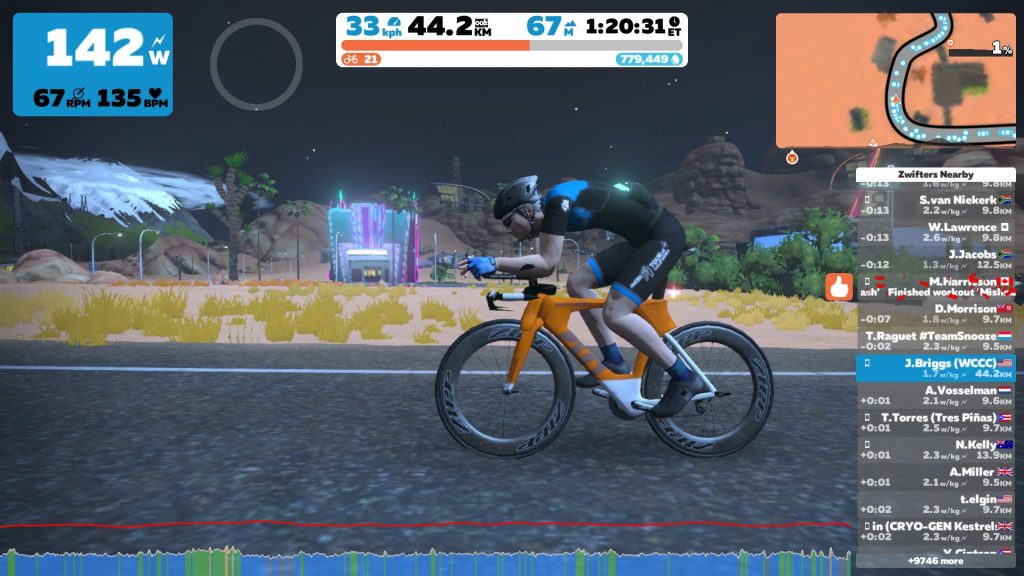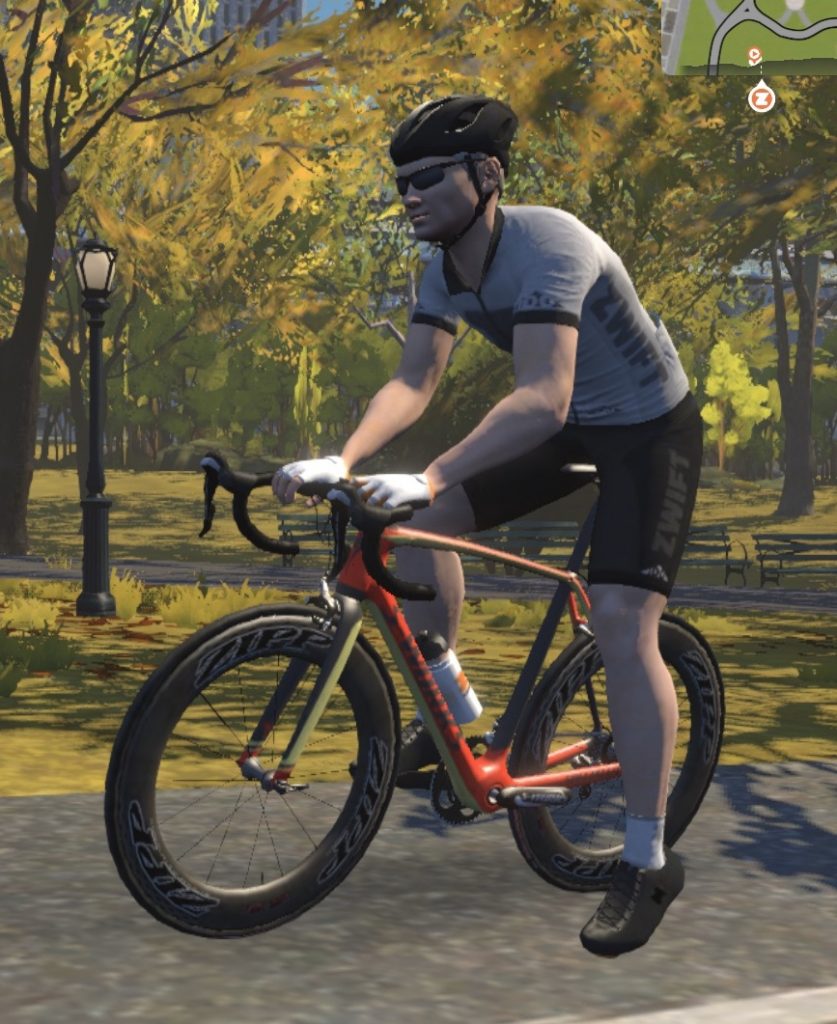This morning I decided that the time had come to snag that cool gray jersey that Zwift awards you when you do a 100km ride. Here’s how I went about it.

Before I start, let me be clear that this post is not about preparing for a metric century in Zwift … you can prepare for it just the same way you’d prepare for an on-the-road MC. I’ll talk a bit about the difference between the “real” metric century and the Zwift version, but as far as preparation I think there are a lot of resources out there to get you prepared (including Zwift’s own Fondo training courses). This post is about the decisions I made about how to approach it in-game, and the experience of actually doing it.
I’m a 100 mile/week rider (if you count the Peloton in there) and have done a few centuries, both the metric and full 100-milers. I’d started a couple of Zwift rides in the past intending to go 100km, but for one reason or another I never actually went the distance. With the local weather somehow locked into a cold, rainy pattern for the past few weeks and not a whole lot to do at home during the lockdown, I decided that today would be the day.
The easy way or the fun way?
I had considered two strategies for tackling the MC in Zwift. One was to pick a longish course such as the Uber Pretzel and just ride it. That was how I had started my last 100k attempt, but after I saw how long it took me to do the first 30k or so I bailed out, figuring it’d take most of the day to do the rest. I am not entirely sure how long it would take me to do that ride… there’s a fair bit of climbing, but in the real world if you begin and end a ride in the same place the ascents and descents are literally equal so the extra effort going up is rewarded by rest coming down. I’m not sure that the same can be said for Zwift. I never really seem to coast through sections like Titan’s grove the way I can through similarly hilly areas near my home. I feel like Zwift cheats me on the downhills… not a big deal since I’m on the thing to train, but still I don’t think the ascents and descents cancel each other out on Zwift nearly as much as they do in real life.
The other approach to doing 100k, the one I chose, was to set things up for myself so that I could complete the 100k as quickly as possible. So the course I chose was Tempus Fugit, the flattest, fastest route in Watopia, and a favorite of people who just want to maximize their MPH (or KPH, as the case may be). 100k on Tempus Fugit has only about 500 feet of climb.
After selecting the course I had to decide on the bike, and I had a conundrum. Should I pick a TT bike for its aero, or should I pick a fast road bike and rely on the draft? You may be aware that in Zwift, you get no aero advantage from drafting behind other riders (they may draft you but you can’t draft them). So if you go TT you’re on your own. With other bikes, you can take advantage of a healthy aero boost when drafting behind a rider (and even more if the group is four or more riders), but that means that others dictate your pace to some extent. Today, being quarantine day #1zillion, there were so many riders on Fuego Flats it was, as they say, a conga line. Finding drafting partners would not be a problem.
After some thought and fruitless googling, I decided to go the TT route, just to simplify things. I selected the Cervélo P5 for the ride. Why that bike? It happened to be in my garage. It was probably the best bike I could afford the last time I did a TT ride and considering how few TT rides I do I wasn’t going to buy another just for this. So the P5 it is.
Getting ready
Although I generally don’t like to eat before a bike ride, most of my Zwift rides are an hour or less so it hardly matters. For what was fixing to be a 3+ hour ride, I was going to need some fuel, so I made myself a breakfast of oatmeal and an orange, and was ready to go. (NB: I am very far from being a sports nutritionist, but this worked for me).
Riding Fuego Flats on a TT bike is just about as dull as Zwift can get. Fuego Flats is, as the name would suggest, pool-table flat, with gradients between -1° and 2°. It’s so monotonous that I could actually feel the one degree changes in gradient, which normally are imperceptible. Add to that that the TT bike cannot draft behind others, and you pretty much can completely ignore the other riders. After all, you can’t crash into them, and you can’t draft off them, so it really doesn’t matter where they are. Riding alone or in a pack of a hundred riders, it’s exactly the same experience. Pick a gear, grind out the miles, and that’s about it. I chose a 33-34 kph pace so I could finish in three hours and settled in.
I took a break around the 50k mark. Just like in real life, I’m looking for a bio-break after about hour #1. I decided to hold out until I was past mid-way, because I wanted to have more behind me than ahead of me when I got back on the bike. I grabbed a bread roll (it was the only thing I could see in there that I could eat while on the bike) and got started again before I got too comfortable not pedaling.
Around the 80k mark, I opened up a pack of Gu. I’m not really into snacking on my ride, but it may just be that I don’t know what I’m doing. I did notice that my time on “Fuego Flats Reverse” seemed to drop about 2-3% each time through, so I was definitely running out of gas. Would the right snacks help? I really don’t know. I do like Gu, though, it’s like candy. My favorite flavor is Chocolate Outrage, but if you’re actually in the middle of a big ride it’s a little hard to get down, so I generally go for the salted caramel. (In case you’re wondering, I am not compensated by Gu for this mention, though at about $1 per gel, I certainly wouldn’t mind them throwing some free product my way)
The 100k mark came and went without a whole lot of fanfare. There was the usual blue banner saying that I’d gotten the badge, followed by the orange banner saying that I unlocked the Metric Century jersey (the whole reason I was doing this, to tell the truth). I was getting close to finishing the timed Fuego Flats Reverse, so I went ahead and finished that. Then I was close to getting 105 km, so I did that, too. (If it weren’t for completionism, I’d probably have half as many Zwift miles as I do!)

Final thoughts
So, after all that, how does a Zwift metric century compare to the real thing? I suppose in terms of effort, it was about the same. I live in a fairly hilly area, so the metric centuries I have done have usually had 3-4000 feet of climb to them, which both requires extra effort at times but also provides some relief. I’ve never just sat and cranked out three hours at a constant pace, and it’s hard to compare.
I think I found it a little less comfortable doing a distance ride on the trainer because the trainer has the bike more or less locked in place. On the road, the bike can sway just a little from side to side as you pedal. That’s particularly noticeable on hills but you still feel it on the flats as well. The trainer doesn’t give you the same jinba ittai that you get on the road, which is a shame. I am not sure I ever plan to do a full 100 mile century ride indoors for just that reason. Then again, if it doesn’t warm up soon around here I will probably be looking for new things to try.
One other thought: if you’re doing an organized event, then the rest stops are set at intervals of the organizer’s choosing, but of course on Zwift you’re making that decision for yourself (assuming you’re not in a group ride), and that may change things a little bit.
In summary, I think I can safely say that if you have completed a metric century in either Zwift or the real world, you probably wouldn’t have trouble doing one in the other. Jumping on your TT bike and heading for Fuego Flats is probably the fastest way to get in your 100k, but exciting it is not.

0 Comments